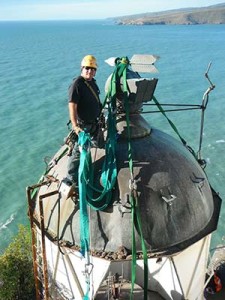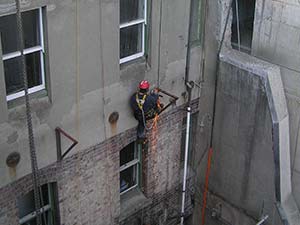Industrial Rope Access
 Industrial rope access is the process of using ropes to access a worksite at height, and usually in the vertical environment. We use three techniques to control fall hazards:
Industrial rope access is the process of using ropes to access a worksite at height, and usually in the vertical environment. We use three techniques to control fall hazards:
- fall restraint
- fall arrest
- work positioning
The Fall restraint technique
Prevents an individual from reaching a fall hazard whilst they undertake their work. This is achieved through the use of barriers or rope.
The Fall arrest technique
Utilises a particular device to stop a worker hitting the ground in the event of a fall. This is our least preferred method of working as an individual can fall a substantial distance before the fall is arrested. This method can expose workers to hitting other objects and quite large body stresses if not managed well.
Using both of these techniques, the rope is secondary to the supporting structure. The rope is only used to prevent a worker reaching the fall hazard or stopping a fall if a worker falls off the structure.
The Work positioning technique
This involves using rope, to abseil down or climb up, to access a worksite and work efficiently on rope. In this system, a worker and their tools are completely supported by their ropes.
All three techniques are used allow individuals to work safely and efficiently at height.
In New Zealand there is a two-tiered industrial rope access system, which is administered by the New Zealand Qualifications Authority (NZQA), overseen by the Industrial Rope Access Association of New Zealand (IRAANZ). The first level, level three on the NZQA framework, teaches individuals about the techniques and equipment required to work on rope including: how to use anchors, moving up and down a rope, moving between ropes, and how to undertake a rescue off rope. The second level, level four, is more advanced and delves deeper into the theories and practicalities of advanced rope access, including lead and aid climbing techniques, using cableways and highlines, moving loads around, and advanced rope rescue.
Solutions 2 Access firmly believes, and demonstrates through our work, that using rope to access a site and undertake particular work at height can be both cost effective and efficient.
 As a leader in the field of industrial rope access in New Zealand, Solutions 2 Access is always looking at pushing the boundaries of rope access and we are constantly on the lookout for new and efficient techniques and methods. Our team leaders are level four qualified and all team members either have level three or four, or are working towards these qualifications. Many of our staff are also involved in both rope rescue or search and rescue and incorporate techniques learnt from such organisations into the workplace.
As a leader in the field of industrial rope access in New Zealand, Solutions 2 Access is always looking at pushing the boundaries of rope access and we are constantly on the lookout for new and efficient techniques and methods. Our team leaders are level four qualified and all team members either have level three or four, or are working towards these qualifications. Many of our staff are also involved in both rope rescue or search and rescue and incorporate techniques learnt from such organisations into the workplace.Sample Projects:
 Synlait milk contacted to Solutions 2 Access to repair the 10m high windows in their drying rooms. The drying plant is a sterile area and all access is strictly controlled. The whole area is under positive pressure and following the Christchurch Earthquakes the windows were leaking and required additional support. The repair was undertaken quickly and efficiently on rope reducing costs substantially by removing the need for scaffolding and the large sterilization requirement.
Synlait milk contacted to Solutions 2 Access to repair the 10m high windows in their drying rooms. The drying plant is a sterile area and all access is strictly controlled. The whole area is under positive pressure and following the Christchurch Earthquakes the windows were leaking and required additional support. The repair was undertaken quickly and efficiently on rope reducing costs substantially by removing the need for scaffolding and the large sterilization requirement.
 Prior to the Canterbury earthquakes Solutions 2 Access was contracted by Fletcher Construction to remove 3 stories of the historic 1920s fire escape from Warners Hotel. Through the use of industrial rope access techniques, we installed anchors on the roof of the building and then removed the fire escape on rope. 5+ tonnes of material was removed from the site. The escape was situated above a NZ Historic Places Trust site, which had a fragile roof and a large stained glass atrium. All material had to be lifted up out of the site with a tower crane.
Prior to the Canterbury earthquakes Solutions 2 Access was contracted by Fletcher Construction to remove 3 stories of the historic 1920s fire escape from Warners Hotel. Through the use of industrial rope access techniques, we installed anchors on the roof of the building and then removed the fire escape on rope. 5+ tonnes of material was removed from the site. The escape was situated above a NZ Historic Places Trust site, which had a fragile roof and a large stained glass atrium. All material had to be lifted up out of the site with a tower crane.
 Solutions 2 Access was contracted by the Department of Conservation to install a 50m cableway to enable access to all parts of the 16m high dam and to undertake remedial work and apply preservation treatment. The structure was initially water blasted and had rotten rafters removed and replaced, which involved the lifting, placement and fixing of 12 large 380PFC steel beams, 300*300mm * 6m long timber beams along with five 12m 500 SED rafters. Beams were positioned and lifted with rope access haulage techniques and the rafters were positioned with a heavy lift helicopter. Upon completion, the whole dam was treated with timber preservative. The site has high environmental values and is in a remote location.
Solutions 2 Access was contracted by the Department of Conservation to install a 50m cableway to enable access to all parts of the 16m high dam and to undertake remedial work and apply preservation treatment. The structure was initially water blasted and had rotten rafters removed and replaced, which involved the lifting, placement and fixing of 12 large 380PFC steel beams, 300*300mm * 6m long timber beams along with five 12m 500 SED rafters. Beams were positioned and lifted with rope access haulage techniques and the rafters were positioned with a heavy lift helicopter. Upon completion, the whole dam was treated with timber preservative. The site has high environmental values and is in a remote location.
 Following the February earthquake the historic Godley Head lighthouse was left in an exposed position on the cliff edge. Solutions to Access were contracted by the department of Conservation to abseil to the site and remove the prism glass and prepare the dome and support to be lifted out with a helicopter. The structure weighted 2 tonnes and the copper dome had to be separated prior to lifting out.
Following the February earthquake the historic Godley Head lighthouse was left in an exposed position on the cliff edge. Solutions to Access were contracted by the department of Conservation to abseil to the site and remove the prism glass and prepare the dome and support to be lifted out with a helicopter. The structure weighted 2 tonnes and the copper dome had to be separated prior to lifting out.
